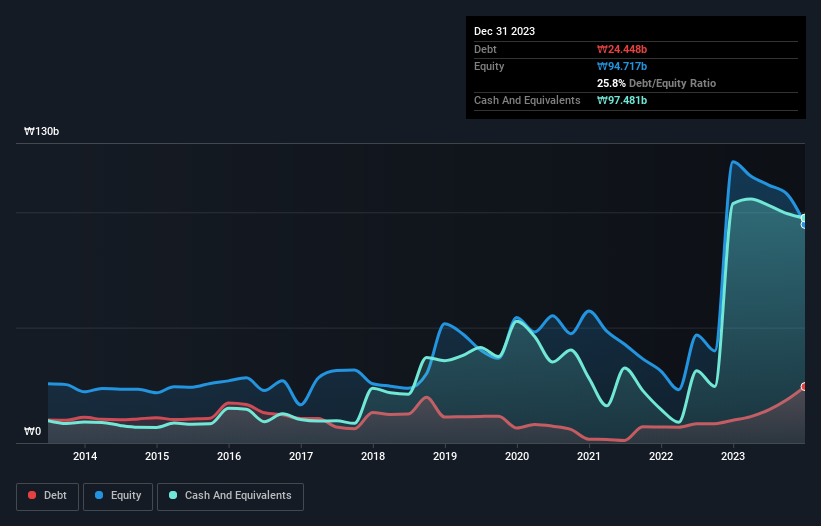Some say volatility, rather than debt, is the best way to think about risk as an investor, but Warren Buffett famously said that 'Volatility is far from synonymous with risk.' So it seems the smart money knows that debt - which is usually involved in bankruptcies - is a very important factor, when you assess how risky a company is. As with many other companies Oscotec Inc. (KOSDAQ:039200) makes use of debt. But the more important question is: how much risk is that debt creating?
Why Does Debt Bring Risk?
Debt assists a business until the business has trouble paying it off, either with new capital or with free cash flow. In the worst case scenario, a company can go bankrupt if it cannot pay its creditors. While that is not too common, we often do see indebted companies permanently diluting shareholders because lenders force them to raise capital at a distressed price. Having said that, the most common situation is where a company manages its debt reasonably well - and to its own advantage. When we examine debt levels, we first consider both cash and debt levels, together.
Check out our latest analysis for Oscotec
What Is Oscotec's Debt?
As you can see below, at the end of December 2023, Oscotec had ₩24.4b of debt, up from ₩9.86b a year ago. Click the image for more detail. However, its balance sheet shows it holds ₩97.5b in cash, so it actually has ₩73.0b net cash.

A Look At Oscotec's Liabilities
According to the last reported balance sheet, Oscotec had liabilities of ₩34.8b due within 12 months, and liabilities of ₩3.01b due beyond 12 months. Offsetting these obligations, it had cash of ₩97.5b as well as receivables valued at ₩2.02b due within 12 months. So it actually has ₩61.6b more liquid assets than total liabilities.
This surplus suggests that Oscotec has a conservative balance sheet, and could probably eliminate its debt without much difficulty. Succinctly put, Oscotec boasts net cash, so it's fair to say it does not have a heavy debt load! The balance sheet is clearly the area to focus on when you are analysing debt. But ultimately the future profitability of the business will decide if Oscotec can strengthen its balance sheet over time. So if you want to see what the professionals think, you might find this free report on analyst profit forecasts to be interesting.
Over 12 months, Oscotec made a loss at the EBIT level, and saw its revenue drop to ₩5.0b, which is a fall of 2.2%. We would much prefer see growth.
So How Risky Is Oscotec?
By their very nature companies that are losing money are more risky than those with a long history of profitability. And we do note that Oscotec had an earnings before interest and tax (EBIT) loss, over the last year. And over the same period it saw negative free cash outflow of ₩23b and booked a ₩24b accounting loss. While this does make the company a bit risky, it's important to remember it has net cash of ₩73.0b. That means it could keep spending at its current rate for more than two years. Even though its balance sheet seems sufficiently liquid, debt always makes us a little nervous if a company doesn't produce free cash flow regularly. The balance sheet is clearly the area to focus on when you are analysing debt. However, not all investment risk resides within the balance sheet - far from it. To that end, you should learn about the 2 warning signs we've spotted with Oscotec (including 1 which is significant) .
If you're interested in investing in businesses that can grow profits without the burden of debt, then check out this free list of growing businesses that have net cash on the balance sheet.
New: AI Stock Screener & Alerts
Our new AI Stock Screener scans the market every day to uncover opportunities.
• Dividend Powerhouses (3%+ Yield)
• Undervalued Small Caps with Insider Buying
• High growth Tech and AI Companies
Or build your own from over 50 metrics.
Have feedback on this article? Concerned about the content? Get in touch with us directly. Alternatively, email editorial-team (at) simplywallst.com.
This article by Simply Wall St is general in nature. We provide commentary based on historical data and analyst forecasts only using an unbiased methodology and our articles are not intended to be financial advice. It does not constitute a recommendation to buy or sell any stock, and does not take account of your objectives, or your financial situation. We aim to bring you long-term focused analysis driven by fundamental data. Note that our analysis may not factor in the latest price-sensitive company announcements or qualitative material. Simply Wall St has no position in any stocks mentioned.
About KOSDAQ:A039200
Oscotec
Operates as a biotechnology company, engages in the drug development, functional materials and related products, and dental bone graft material businesses.
Exceptional growth potential with excellent balance sheet.
Market Insights
Community Narratives




